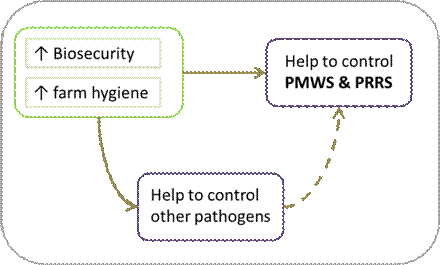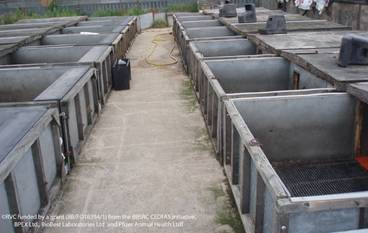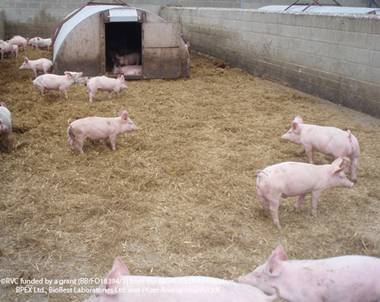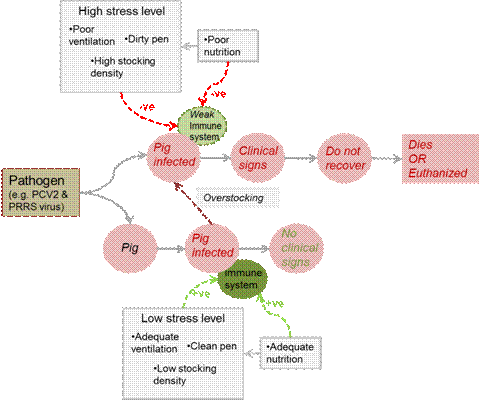Biosecurity and farm management
Regardless of the strategy chosen when trying to control PMWS and PRRS, biosecurity measures and farm hygiene are extremely important. The good news is that, improving biosecurity and farm hygiene will also help to control other pathogens. Controlling other pathogens will help reduce the risks associated with PMWS and PPRS.


Internal and external biosecurity are equally important. External biosecurity aims at preventing introduction of new pathogens and, in the case of PRRS, co-infections or new strains and the possibility of new outbreaks. Internal biosecurity and good hygiene on the other hand address spread of the virus within the farm.
External biosecurity
In the previous units it was explained that contaminated overalls, boots, transport vehicles and equipment can serve as means of carrying viruses from an infected farm to a negative farm and to the spread within a farm (particularly important for PRRS). Therefore, cleaning and disinfection of clothing, vehicles and equipment before and after contact with animals is essential. Boot baths should be provided at the entrance of the farm.
Visitors should be avoided as much as possible, especially in buildings where the pigs are kept. However, when visitors enter a farm they should wear protective clothing and footwear and if possible, shower in before entering the pig section. Disposable boots and clean overalls should be provided at the farm to prevent mechanical transmission. Visitors should ensure that their vehicles and equipment are clean and ideally, be at least 2 days pig free (i.e. at least 2 days without any contact with pigs -abattoir, farm, livestock markets, etc-)
If new pigs are to be introduced in the farm, these should come from PRRS free farms and with no PMWS clinical signs. Additionally, new pigs should be quarantined.
Trucks must be cleaned thoroughly before a new lot of animals are loaded. This will help avoid the entry of viruses (especially PRRS) onto the farm. Make sure ceilings, walls and floors are brushed and hosed clean, and that you do not miss wheel arches, mudguards, mud flaps and any parts of the vehicle where pigs have been. Once the truck is clean, simple approaches such as using a low pressure foaming system and an appropriate disinfectant (products containing oxidizing agents, halides or sodium hydroxide) have proved to be sufficient to reduce virus levels. The important point is to make sure that proper and systematic cleaning and disinfection are done all the times.
Techniques such as heating and drying trailers or the use of robots to spray and clean them can be really efficient on reducing virus levels; however these techniques tend to be expensive and laborious to carry out, so not all farms will be able to afford them and maintain them.
Internal biosecurity and farm management
Similar to trucks, pens must be cleaned thoroughly before a new lot of animals come onto a farm. This will help avoid the spreading of viruses within the farm. Make sure all manure and bedding is removed. Once the pens are clean, disinfect them using a low pressure foaming system and an appropriate disinfectant.
Orientation of sheds should be planned in relation to prevailing wind, making sure that there is enough distance between sheds to minimise aerosol transmission as much as possible (mainly in the case of PRRS)

Pens cleaned thoroughly before the introduction of new animals
As you have seen before, good husbandry avoids stress and therefore pigs seem more likely to be able to successfully fight infection if it should occur.
Stocking density is a predisposing factor for PMWS and PRRS, so try to stock all pens with a small number of animals, but more importantly, at a low stocking density (the recommended area is between 0.75 to 1m2 / finishing pig, and as a rule of thumb pigs should be able to walk around and move freely without causing interference to other pigs in the pen). If low stocking densities are used, pig to pig contact will be decreased and stress in pigs will be reduced. Additionally make sure all pens have adequate ventilation and temperature: sows 15-20°C; weaned pigs (3-4 weeks) 27-32°C; weaned pigs (more than 4 weeks) 22-27°C; finishing pigs 15-21°C. Avoid abrupt fluctuations in temperature.

Pen with adequate stock density. Dividers between pens are solid walls avoiding pig contact between pens
How do extreme temperatures affect pig performance?
Other factors helping minimise spread of disease within a farm are avoiding cross fostering after 24 hours of age, and using an all-in / all-out policy in the weaning and farrowing accommodation (followed by thorough cleaning and disinfection) as this will help keep viruses and other pathogens at low levels and limit the risk of disease.
Adjust the pigs' diet according to the stage of production in order to keep them as healthy as possible. Diet requirements change as pigs grow. Diet should be matched for the age of the pig, for example the amount of protein relative to energy changes as the pigs grow, while more protein is needed in early stages, less protein is needed in the finishing stage. Changes should be introduced gradually, and it may be helpful to review the pigs' diets with a vet or nutritionist. Balanced nutrition is important for growth but also, pigs receiving the appropriate nutrients will have a stronger immune system and therefore will be better off to fight pathogens.
In summary, avoid stressing pigs as this might compromise their immune system and ability to fight pathogens. The diagram below shows how stress levels and nutrition can impact the ability of a pig to fight disease


A sick pen is recommended to separate pigs that are suspected of having an infection. Ideally this pen should be as far apart as possible from the weaning pens, and the drain of the sick pen must not pass through other areas holding pigs. When sick pigs recover, it is not recommended to bring them back to their original pen; ideally there should be a pen for recovered pigs.
Minimise the access of trucks onto the farm as much as possible. For example, pigs going for slaughter should be collected only from an isolated unit at the farm gate.
Provide boots disinfection or changing boots between units, and make sure you change the disinfectant regularly. In large farms, personnel at the farm should have specific and well established duties. Unnecessary movement of personnel between sections should be avoided. Similarly, one way flow movement of the pigs in the farm is recommended.
Outdoor units should be sited on well drained land. Areas holding surface water should be fenced-off or drained.
Keep production and health records systematically and up to date. This is critical if one wants to spot, as soon as possible, any abnormality within the farm (e.g. mortality increase in the case of PMWS).
Some biosecurity programmes and plans to decrease stress and infection pressure have been proposed when trying to control PMWS and PRRS (MCREBEL and Plan Madec are the two best known). Although these programmes can be used as a starting point, each farm should be evaluated individually with a vet in order to identify specific issues and areas that need improvement.
MCREBEL (Management Changes to Reduce Exposure to Bacteria to EliminateLosses) and a modification of this programme 'Management Several Strategies to Reduce the Risk of Virus Spread' covers eight measures:
- Only cross foster during the first 24 hours of life;
- Do not move sows or piglets between rooms;
- Eliminate the use of nurse sows;
- Humanely destroy piglets that become sick and are unlikely to recover;
- Minimize handling of piglets, especially administration of routine antibiotics or extra iron injections;
- Do not transfer undersized pigs back to rooms containing younger litters;
- Immediately avoid any potential contact between infected animals and non-infected animals.
- Move nursery pigs according to strict all-in /all-out principles, allowing for 2-3 days between groups for cleaning and disinfecting
Dee, S et al, 1996. Control of porcine reproductive and respiratory syndrome (PRRS) virus. Swine health and production
The Madec approach. 20 ways of reducing the impact of PMWS.
Farrowing sector
1. Empty manure pit, clean and disinfect between batches (all-in/all-out must be strictly applied)
2. Wash sows + treat for parasites before farrowing
3. Cross-fostering - must be limited to necessary cases - within 24h
Post-weaning sector
4. Small pens (<13 pigs per pen), solid partitions
5. Empty manure pit, clean and disinfect, all-in / all-out
6. Stocking density (3 pigs/m2)
7. Space at the feeder 7+ cm/piglet
8. Air quality: perfect (NH3<10ppm, CO2<0.15%)
9. Avoid stress due to temperature changes
10. No mixing of batches
Finishing sector
11. Small pens, solid partitions
12. Empty manure pit, clean and disinfect, all-in / all-out
13. No mixing between "PW Pens"
14. No mixing between buildings
15. Stocking density: 0.75+ m2 / pig
16. Air quality (NH3<10ppm, CO2<0.15%), avoid stress due to temperature changes
Others
17. Appropriate vaccination programme
18. Adequate ventilation within buildings
19. Strict hygiene (e.g. castration, injections)
20. Early removal of sick pigs to hospital room
NPA PMWS/PDNS Meeting East Yorkshire: 12 June 2001. Speaker: Dr Francois Madec